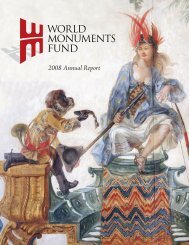Summary of the Proceedings and Papers Presented at - World ...
Summary of the Proceedings and Papers Presented at - World ...
Summary of the Proceedings and Papers Presented at - World ...
You also want an ePaper? Increase the reach of your titles
YUMPU automatically turns print PDFs into web optimized ePapers that Google loves.
The History <strong>of</strong> <strong>the</strong> House<br />
<strong>of</strong> <strong>the</strong> Silver Wedding Anniversary<br />
by Wolfgang Ehrhardt <strong>and</strong> Fabrizio Pes<strong>and</strong>o<br />
italiano<br />
The importance <strong>of</strong> <strong>the</strong> House <strong>of</strong> <strong>the</strong> Silver Wedding<br />
Anniversary in Pompeii (V 2,i) is based upon a unique<br />
combin<strong>at</strong>ion <strong>of</strong> architectural, art-historical <strong>and</strong> sociological<br />
facts <strong>and</strong> <strong>the</strong> quality <strong>of</strong> <strong>the</strong> preserved wallpaintings.<br />
This house is one <strong>of</strong> <strong>the</strong> less than twenty properties<br />
in Pompeii for which we have inform<strong>at</strong>ion about <strong>the</strong><br />
owner. From <strong>the</strong> time <strong>of</strong> Claudius, <strong>the</strong> house had been in <strong>the</strong><br />
h<strong>and</strong>s <strong>of</strong> L. Albucius Celsus I, <strong>and</strong> afterwards those <strong>of</strong> his<br />
son L. Albucius Celsus II. Both men were <strong>at</strong>tested aediles<br />
<strong>and</strong>, <strong>the</strong>refore, members <strong>of</strong> Pompeii’s high society. Although<br />
we do not know <strong>the</strong> name <strong>of</strong> <strong>the</strong> man who built <strong>the</strong> house in<br />
<strong>the</strong> last quarter <strong>of</strong> <strong>the</strong> 2 nd century BC, it is quite clear from<br />
<strong>the</strong> architecture th<strong>at</strong> he must have been rich <strong>and</strong> powerful.<br />
The house occupies an area <strong>of</strong> about 1700 square meters.<br />
Its <strong>at</strong>rium columns are 6.90m high, <strong>the</strong> <strong>at</strong>rium itself occupies<br />
197 square meters. The house enclosed two peristyles, <strong>the</strong><br />
smaller <strong>the</strong> oldest peristyle <strong>of</strong> <strong>the</strong> Rhodian type in Pompeii.<br />
During th<strong>at</strong> phase <strong>the</strong> rooms east <strong>of</strong> <strong>the</strong> <strong>at</strong>rium had a double<br />
face. From <strong>the</strong> <strong>at</strong>rium <strong>the</strong>ir entrances looked like normal<br />
doors leading into cubicula. But upon entering <strong>the</strong>se rooms<br />
<strong>the</strong>y changed into reception rooms giving free sight to <strong>the</strong><br />
vast garden area east <strong>of</strong> <strong>the</strong> <strong>at</strong>rium complex. The house remained<br />
untouched until 40 BC.<br />
Major changes in <strong>the</strong> building’s structure were effected <strong>at</strong><br />
this time, <strong>and</strong> consequently in <strong>the</strong> floor <strong>and</strong> wall decor<strong>at</strong>ions.<br />
Also around <strong>the</strong> same period, <strong>the</strong> owner decided to add a<br />
second floor around <strong>the</strong> <strong>at</strong>rium. Th<strong>at</strong> construction called for <strong>the</strong> lowering <strong>of</strong> <strong>the</strong> ceilings inside <strong>the</strong> rooms around <strong>the</strong><br />
<strong>at</strong>rium. Then also <strong>the</strong> famous colonnaded oecus was constructed.<br />
It was <strong>at</strong> this point th<strong>at</strong> <strong>the</strong> entire house lost <strong>the</strong><br />
old decor<strong>at</strong>ion in <strong>the</strong> First Style <strong>and</strong> was redecor<strong>at</strong>ed in <strong>the</strong><br />
contemporary Second Style. The Casa delle Nozze d’Argento<br />
remained thus until Neronian times.<br />
The house’s last building phase can be d<strong>at</strong>ed by a graffito<br />
to <strong>the</strong> years before 60 AD. The b<strong>at</strong>h complex was constructed<br />
<strong>at</strong> this time with a tepidarium, a caldarium <strong>and</strong> a pool outside<br />
in an open garden area, as well as a separ<strong>at</strong>e toilet with<br />
polychrom<strong>at</strong>ic wall decor<strong>at</strong>ions <strong>and</strong> a w<strong>at</strong>er tap. Also during<br />
this phase, <strong>the</strong> wide openings between <strong>the</strong> rooms east <strong>of</strong> <strong>the</strong><br />
<strong>at</strong>rium <strong>and</strong> <strong>the</strong> gymnasium-like garden were closed entirely.<br />
All <strong>the</strong>se changes were ordered by L. Albucius Celsus I. He<br />
wisely kept <strong>the</strong> older wall decor<strong>at</strong>ions painted in <strong>the</strong> Second<br />
Style, adding to <strong>the</strong>se some new decor<strong>at</strong>ions in <strong>the</strong> Fourth<br />
Style. His behavior is markedly different from th<strong>at</strong> <strong>of</strong> <strong>the</strong> previous<br />
owner who had ordered <strong>the</strong> total removal <strong>of</strong> <strong>the</strong> First<br />
Style decor<strong>at</strong>ions. The house suffered minor damage during<br />
<strong>the</strong> earthquake <strong>of</strong> 62 AD. Although <strong>the</strong> b<strong>at</strong>h complex was not<br />
used, <strong>the</strong> house itself was not ab<strong>and</strong>oned by its last owner,<br />
L. Albucius Celsus II. Thus <strong>the</strong> House <strong>of</strong> <strong>the</strong> Silver Wedding<br />
Anniversary maintained from its beginning until <strong>the</strong> eruption<br />
<strong>of</strong> Vesuvius <strong>the</strong> character <strong>of</strong> a palace-like townhouse built to<br />
house a member <strong>of</strong> Pompeii’s highest society.
















